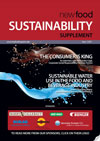Sustainability supplement 2011
7 July 2011 | By Alessandro Cagli, Corporate Social Responsibility Director, Ferrero and Jean-Christophe Bligny, Environmental Director, Danone Waters
Featuring articles: "The consumer is king" - an interview with Alessandro Cagli, Corporate Social Responsibility Director, Ferrero"Sustainable water use in the food and beverage industry" by Jean-Christophe Bligny, Environmental Director, Danone Waters





